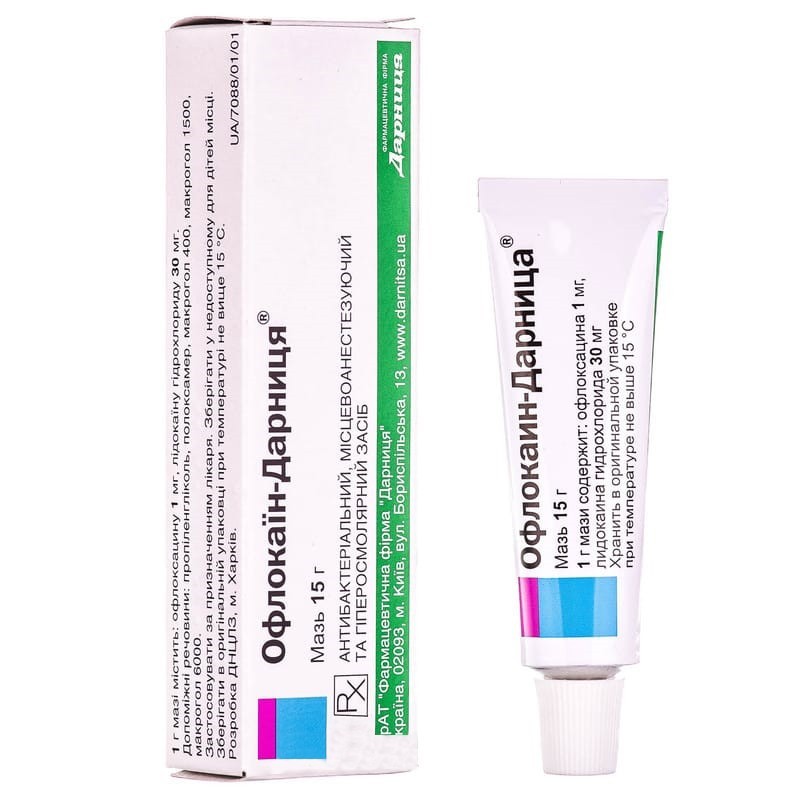



 Secure and encrypted payment processing
Secure and encrypted payment processing We ship to over 40 countries including the USA, UK, Europe, Australia and Japan
We ship to over 40 countries including the USA, UK, Europe, Australia and Japan Guaranteed refund or reship if you haven't received your order
Guaranteed refund or reship if you haven't received your orderOflocaine-darnitsa is a combination of an antimicrobial agent of the fluoroquinolone group, ofloxacin and a local anesthetic, hydrophilic, hyperosmolar and water-soluble lidocaine. The pharmacological effects of the ointment are due to the properties of the active substances.
Ofloxacin acts on the bacterial enzyme DNA gyrase and bacterial topoisomerase IV, which ensures supercoiling and stability of bacterial DNA. It has a bactericidal effect due to the destabilization of bacterial DNA chains.
Ofloxacin provides the antimicrobial properties of the ointment by acting on gram-positive and gram-negative bacteria (to a greater extent), aerobic and anaerobic, spore-forming and asporogenic microflora in the form of monocultures and microbial associations. Ofloxacin is also effective against hospital strains resistant to antibiotics and sulfonamides.
The hyperosmolar, polymer ointment base of the drug provides fluid movement in the wound towards the ointment base. Due to this, edema of tissues around the wound decreases, purulent necrotic masses are sorbed. Excipients of the ointment base are able to transport ofloxacin to the tissues surrounding the wound, as a result of which it affects both superficial and deep wound infections.
The mechanism of the local anesthetic action of lidocaine is to stabilize the neuronal membrane by reducing its permeability to sodium ions, which prevents the emergence of an action potential and the conduction of impulses along nerve fibers. Possible antagonism with calcium ions. Suppresses the conduct of not only pain impulses, but also impulses of another modality. It is rapidly hydrolyzed in a slightly alkaline tissue environment and, after a short latent period, acts for 60–90 minutes. The anesthetic effect of lidocaine is 2-6 times stronger than procaine. When applied topically, it dilates blood vessels, does not have a local irritant effect. With inflammation (tissue acidosis), the anesthetic activity decreases. Effective with all types of local anesthesia. Expands blood vessels. It does not irritate the tissue.
Pharmacokinetics Ofloxacin and lidocaine practically do not enter the systemic circulation when applying ointment to healthy skin. After application to the wound surface in case of violations of the barrier functions of the skin, about 3% of the applied dose of ofloxacin enters the systemic circulation. The peak concentration of the substance in the blood is observed after 3-4 hours. 6 hours after the application of the ointment ofloxacin in the blood is not determined.
Complicated infected wounds in the first phase of the wound process of various localization and origin (amputation stumps of the extremities, wounds after surgical treatment of purulent foci, pressure sores, trophic ulcers, complicated postoperative wounds and fistulas, abscesses and phlegmons of the maxillofacial region, etc.) after their surgical treatment .
Prevention and treatment of suppuration of burn wounds.
Purulent-inflammatory skin diseases caused by bacterial microflora sensitive to ofloxacin.
Locally. after treating wounds and burns, the ointment is applied directly to the wound surface, then a sterile gauze dressing or ointment is applied, applied to the dressing, and then the wound is covered with it. swabs saturated with ointment loosely fill the cavity of purulent wounds after surgical treatment, and gauze turundas with ointment are introduced into the fistulous course.
In the treatment of purulent wounds, the ointment is used 1 time per day, in the treatment of burns - daily or 2-3 times a week, depending on the amount of purulent discharge. The dose of the drug is due to the area of the wound surface (the ointment should cover the entire affected area) and the degree of purulent exudation.The duration of treatment depends on the dynamics of cleansing the wound from purulent exudate and eliminating the inflammatory process.
When treating patients with skin diseases, a thin layer of ointment is applied to the affected areas 1-2 times a day or on a gauze dressing with subsequent application to the lesion.
Hypersensitivity to ofloxacin or other quinolone derivatives; hypersensitivity to lidocaine hydrochloride or to other local amide type anesthetics (e.g. bupivacaine, ethidocaine, mepivacaine and prilocaine); hypersensitivity to other components of the drug.
When using the ointment, such reactions can occur: itching, burning sensation, rash, hyperemia, weeping, allergic reactions, including dermatitis, urticaria, and angioedema. propylene glycol, which is part of the drug, can cause skin irritation.
Before applying the drug to the wound surface, it is advisable to rinse the wound with aseptic r-rum.
Use during pregnancy and lactation. The drug is not used during pregnancy and lactation.
Children. Oflocaine-Darnitsa is not used to treat children.
The ability to influence the reaction rate when driving vehicles or working with other mechanisms. The drug does not affect the speed of neuromuscular conduction, in the recommended doses it can be used by persons driving vehicles and working with complex mechanisms.
The absorption of lidocaine through the skin is usually low, however, it is necessary to use the drug with caution in patients taking class I antiarrhythmic drugs (tocainide, mexiletine) or other local anesthetics, since there may be a risk of combined systemic effects. MAO inhibitors enhance the local anesthetic effect of lidocaine.
No cases of overdose have been reported.
In the original packaging at a temperature not exceeding 15 ° C.